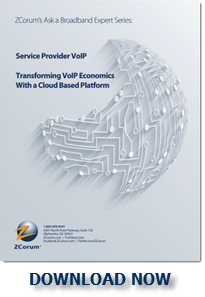Kevin Mitchell on Digital Voice Opportunities
Voice communications remain essential to individuals and businesses. This presents great digital voice opportunities for broadband service providers, who can offer an additional service over their broadband connection and gain some significant new revenue while they’re at it.
You may think it all seems pretty complicated. There’s equipment to buy and manage, right? What about carrier services, managing and porting phone numbers call detail records, e911, CALEA? Fortunately, there’s a much easier and more cost effective way to quickly enter the voice market. And, for those who are already providing voice service, it’s easy to expand into new markets or update to a next gen voice platform.
 Our Broadband Expert this month is Kevin Mitchell, and Kevin is definitely a digital voice expert. He’s currently Vice President of Marketing and Products at Alianza, an emerging cloud-based voice provider for service providers. Prior to Alianza, Kevin worked in marketing for Acme Packet, the vendor that put session border controller on the map, and before that he was a Principal Analyst for Infonetics Research, a telecom market research firm. In today’s post, Kevin makes the case for why broadband service providers should be offering voice, and tells us the best way to do it.
Our Broadband Expert this month is Kevin Mitchell, and Kevin is definitely a digital voice expert. He’s currently Vice President of Marketing and Products at Alianza, an emerging cloud-based voice provider for service providers. Prior to Alianza, Kevin worked in marketing for Acme Packet, the vendor that put session border controller on the map, and before that he was a Principal Analyst for Infonetics Research, a telecom market research firm. In today’s post, Kevin makes the case for why broadband service providers should be offering voice, and tells us the best way to do it.
Voice in a Broadband World
ZCorum: In the world of broadband and data, why do voice services matter?
Kevin: First off, the North American voice market is immense—it totaled nearly $80 billion in 2013—and is still essential to residential and business subscribers. And the annual churn and substitution is slowing, even plateauing.
Secondly, service bundling continues to be a popular. According to a new Digital TV Research report, multi-play will dominate: in 2018 86% of subscription revenue will be a bundle of  multiple services. To be competitive, voice needs to be part of the mix.
multiple services. To be competitive, voice needs to be part of the mix.
Thirdly, business VoIP and UC services represent a growth area and significant new revenue. Pick your firm—Frost & Sullivan, Garter, Infonetics—they all say business VoIP is hot and growing and is a multi-billion dollar services market. SMBs in particular are growth areas as the majority of businesses in U.S. are SOHOs and SMBs. There are 21 million sole proprietorships and 5.9 million SMBs according to the U.S. Census Bureau. And they are under-served and could use feature-rich VoIP services along with the service and support of their local provider.
ZCorum: Are there opportunities to launch new voice services today?
Kevin: Absolutely. There are thousands of ISPs—wireless, municipal broadband, utilities—along with managed IT providers and VARs and many lack voice today. Voice represents net new revenue to these operators. Also, some providers may only have services for their residential customers, and have not yet capitalized on the opportunity to serve the small and medium businesses in their territory. Again, a new revenue opportunity and one that addresses an underserved market. Lastly, providers may be constrained to a specific geography and are seeking an opportunity to bring voice and data to new markets. All of these initiatives have new voice service introduction possibilities.
ZCorum: So how do broadband providers take advantage of this opportunity?
Kevin: Voice is attractive, but the traditional ways of delivering and managing VoIP are not. VoIP and IMS networks are expensive to build and run, inflexible and complex to operate. White label offerings are essentially “me too” services at higher prices.
Fortunately, there is a new way forward and one that I think is the clear choice for voice: the cloud voice platform. This is moving beyond cloud VoIP in the form that service providers deliver to consumers and business. It’s actually leveraging the cloud or “cloud sourcing” voice network infrastructure solutions.
ZCorum: What should a broadband operator look for in launching VoIP services?
Kevin: From our experience with providers newly launching voice, there are four key characteristics to success:
- Easy to manage – this means comprehensive, intuitive web-based management tools and standards-based APIs for integration with back-office systems. To scale efficiently, it’s key to eliminate swivel chair and manual processes. Also, the solution needs to extend ease of management to subscribers with ready-to-go, brandable portals for residential, business administrator and SMB end-users. For providers, the focus should be on signing up and caring for customers, not managing technology.
- Feature-rich – to maximize the opportunity and be competitive, the voice solution needs to provide a deep feature set to address the demands from residential and SMB customers. The solution also needs to be flexible and customizable in terms of what services the provider wants to bring to market.
- High quality – the number-one feature is always centered on quality and reliability. This boils down to service uptime and the quality of experience from the calls.
- Success-based business model – service providers need a model that eliminates CAPEX, maximizes gross margins and minimizes the risk of a new service launch. The cloud provides the answer with a SaaS model that aligns costs with revenue streams at all times. The combination of cloud economics and management simplicity, also promises a superior total cost of ownership over the lifetime of the service.
ZCorum: Can companies that invested in older telecom equipment take advantage of a cloud-based VoIP solution?
Kevin: Yes, absolutely. There are multiple use cases that cloud-based VoIP solutions can power if a service provider has an existing network, including launching new hosted IP PBX services or expanding to new markets. I’d also like to emphasize that the compelling cost savings and improved service agility can easily justify a switch to cloud for your established voice services. Next gen voice belongs in the cloud and we see many telcos, cable operators and others moving that way as next-gen network decisions come up. And with an experienced migration team, this can be a very easy and quick process.
Want to learn more about how to provide VoIP service without buying and managing all of the infrastructure. Check out this white paper on Transitioning VoIP Economics Using a Cloud-Based Platform.
About the Author: Rick Yuzzi

Never miss a post.
Enter your email to subscribe:
- Ask an Expert (12)
- Blog (12)
- Technology (11)
- Hot Topics (8)
- ask a broadband expert (8)
- DOCSIS (7)
- PNM (7)
- proactive network maintenance (7)
- Industry Perspectives (5)
- BEAD (4)
- Broadband Funding (4)
- Customer Service (4)
- FCC (4)
- IIJA (4)
- PreEqualization Analyzer (4)
- correlation groups (4)
- fiber broadband (4)
- fiber optics (4)
- fiber troubleshooting (4)
- interview (4)
- CGNAT (3)
- Carrier Grade NAT (3)
- DDoS Attacks (3)
- DOCSIS pre-equalization (3)
- Diagnostics (3)
- Distributed Denial of Service Attacks (3)
- GPoN (3)
- IPv4 Conservation (3)
- Purchase IPv4 Addresses (3)
- What is DOCSIS PNM (3)
- broadband infrastructure funding (3)
- fiber (3)
- 5G (2)
- CALEA (2)
- CALEA Compliance (2)
- Codeword Errors (2)
- DOCSIS 3.1 (2)
- Distributed Access Architecture (2)
- Group Delay (2)
- ICFR (2)
- IP traffic (2)
- IPv6 migration (2)
- In Channel Frequency Response (2)
- Main Tap Compression (2)
- Marketing (2)
- Micro Reflections (2)
- Millimeter Wave (2)
- OTT (2)
- Rural Broadband (2)
- Types of DDoS Attacks (2)
- Voice Service (2)
- XGS-PON (2)
- broadband data collection (2)
- customer service (2)
- internet issues (2)
- mid-band spectrum (2)
- mmWave (2)
- network traffic (2)
- network virtualization (2)
- state broadband (2)
- state broadband program (2)
- weather-related Internet issues (2)
- 10G (1)
- BDC (1)
- BDC Availability Data Specification (1)
- BDC User Guide (1)
- BEAD Funding (1)
- Broadband Providers (1)
- Broadband Serviceable Location Fabric (1)
- Broadband Serviceable Locations (1)
- C-Band (1)
- CA Certificate Expiration (1)
- CAF II Requirements (1)
- CAF II Testing (1)
- CALEA SSI Plan (1)
- CBRS (1)
- Carpet Bombing (1)
- Citizens Broadband Radio (1)
- Communications Assistance for Law Enforcement Act (1)
- Connect America Fund (1)
- DAA (1)
- DOCSIS 4.0 (1)
- DOCSIS CA Certificate Expiration (1)
- DPoE (1)
- DPoG (1)
- EPoN (1)
- Excel Text Matching (1)
- Extended Spectrum DOCSIS (1)
- Extending HFC Life (1)
- FCC Broadband Map (1)
- FCC data (1)
- FTTH (1)
- FTTx (1)
- Fidelity Communications (1)
- Full Duplex (1)
- Greenfield Broadband (1)
- Hosted VoIP (1)
- IPTV (1)
- IPv4 (1)
- IPv6 (1)
- IPv6 Transition Plan (1)
- LTE (1)
- Low Latency DOCSIS (1)
- MAC/PHY (1)
- Mobile (1)
- Monitoring (1)
- Motivation for DDoS Attacks (1)
- Multi-Vector DDoS Attacks (1)
- NG-PON2 (1)
- NIST (1)
- NIST Cybersecurity Framework (1)
- NIST requirements (1)
- NetFlow (1)
- Network Traffic Management, (1)
- OTT video streaming (1)
- Private Access License (PAL) (1)
- RDOF Auction (1)
- RDOF Voice Requirements (1)
- Remote MAC/PHY (1)
- Remote PHY (1)
- Robocalls (1)
- Rural Broadband Network Advancement Act (1)
- Rural Digital Opportunity Fund (1)
- SSI (1)
- STIR/SHAKEN (1)
- Small Cells (1)
- Streaming (1)
- System Security and Integrity Plan (1)
- TV Viewership Analytics (1)
- TWDM-PON (1)
- TruVizion (1)
- Underserved Locations (1)
- Unserved Locations (1)
- Upstream Analyzer (1)
- Videos (1)
- VoIP (1)
- VoIP revenue (1)
- Wired Broadband (1)
- broadband data collection program (1)
- broadband deployment (1)
- broadband support (1)
- cableLabs (1)
- caf ii (1)
- case study (1)
- cloud-based VoIP (1)
- commercial VoIP (1)
- commercial VoIP revenue (1)
- cpe spectrum capture (1)
- customer service tip (1)
- cyber attacks (1)
- cybersecurity (1)
- dhcp (1)
- downstream spectrum issues (1)
- dual stack implementation (1)
- dynamic spectrum sharing (1)
- electric membership cooperatives (1)
- fiber Internet (1)
- fiber deployment (1)
- forward path monitoring (1)
- free download (1)
- full band capture (1)
- holiday customer service (1)
- holiday tech support (1)
- ingress (1)
- middle mile grant program (1)
- net neutrality (1)
- open access fiber (1)
- open access fiber network (1)
- open access networks (1)
- pppoa (1)
- pppoe (1)
- pre-equalization (1)
- reduced maintenance costs (1)
- remote spectrum analyzer (1)
- return path (1)
- scott helms (1)
- technical paper (1)
- technical support (1)
- vTDR (1)
.
About the Blog
Bloggers
Comments Policy
Guest Blogging
Privacy Policy



Leave a comment: